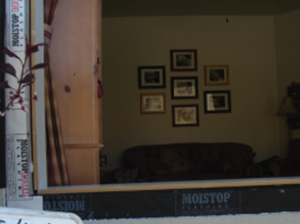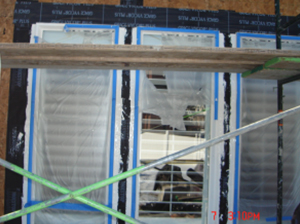Ensuring the durability of buildings is of utmost importance in multi-family units and HOA (Homeowners Association) communities. An essential part of this maintenance involves thoroughly examining the building envelope, which acts as a protective barrier separating the inside and outside of a structure. Thorough inspections of the building envelope are crucial in detecting any potential construction issues that may result in significant and expensive damages, especially in relation to the roof, stucco siding, and window seals.
Stucco siding is a favored option for numerous properties because of its long-lasting nature and attractive appearance. Nevertheless, issues with stucco application or upkeep can result in significant water damage. It's important to address any small cracks or gaps in the stucco to prevent water from seeping in and causing potential damage underneath.Stains or discoloration on the stucco surface may suggest water infiltration and potential mold growth. When stucco starts to bulge or bubble, it could indicate the presence of water trapped behind the surface. Identifying these signs early on with the help of expert inspections can effectively stop the growth of mold, rot, and structural problems.
Another frequent issue that can cause water damage is faulty window seals. Moisture build-up between panes of double-glazed windows can indicate a broken seal, causing issues with the window. Noticing drafts around windows can indicate that the seals may not be working properly. When you notice water stains on your walls or around your window frames, it's a clear indication that there may be an issue with the seals allowing water to seep in. When window seals fail, water can seep into the surrounding walls, leading to potential damage to insulation, framing, and interior finishes. Dealing with these concerns in a timely manner is essential for preserving the structural soundness of the building.
Roofing problems often arise in multi-family and HOA properties. Visible water stains on ceilings or walls can be clear indicators of a leaking roof. It is important to address any issues with the roof, such as missing, cracked, or curled shingles, as they can lead to water damage. When a roof deck begins to sag, it is usually a sign of significant water damage and potential structural issues. Hidden water damage beneath the surface of a roof can be quite sneaky, often remaining undetected until substantial damage has already taken place. Regular inspections are crucial for identifying potential issues early on, which helps prevent costly repairs and ensures the safety of residents.
Identifying construction defects at an early stage can result in significant cost savings for property owners and managers. If water damage is not addressed promptly, it can lead to more serious issues like the growth of mold, damage to the structure, and a decline in indoor air quality. These problems not only demand expensive fixes but can also pose health hazards for residents, causing worries about liability for property owners.
A proactive property management strategy uses building envelope inspectors. Advanced technologies and techniques help these professionals find concealed flaws that the untrained eye cannot. A thorough maintenance plan for multi-family units and HOA communities should include regular inspections to identify and resolve any issues before they become major difficulties.
Dry rot is a form of wood decay that occurs when specific types of fungi consume the structural components of the wood, compromising its strength and rigidity. It is notorious for its ability to silently weaken wooden structures without any apparent external indications. Utah's specific climate conditions, characterized by high altitude and extreme weather changes, can potentially lead to the growth of dry rot when wood is exposed to moisture.Typically, dry rot tends to develop in areas where water seeps into the house. As the fungus matures, it causes the lumber to shrink and develop cracks.
It is important for homeowners to regularly inspect the exterior surfaces for any signs of damage, such as darker wood or cracks and crumbling. Changes in texture or a spongy feel when touched can be signs of wood that has been affected by dry rot. In addition, if you notice paint or finishes that have an uneven appearance, with areas of bubbling or flaking, it could indicate the possibility of dry rot underneath.
Window damage caused by poor installation flashing can be observed at the lower corners of the windows and then extends outward. In some instances, the entire wall area beneath the window may be severely decayed. Decay As a result of kick-out flashing or step flashings that have improperly constructed connections between eave to wall, eave to roof, or roof to wall, are a frequent issue.
Overlooking these indicators during routine inspections can result in more significant harm. Dry rot has the ability to rapidly spread and can even travel through non-wood materials to reach other wooden structures. Failure to address dry rot can have serious consequences, such as compromising the stability of your home and incurring substantial expenses for intricate repairs or replacements. Homeowners must remain vigilant and proactive in order to safeguard their homes from this widespread problem.
Prior to commencing any construction repairs for a wet wall issue, it is crucial for homeowners to identify the source of water leakage and carry out the necessary repairs to prevent any potential issues in the future. Hiring a professional home exterior contractor will speed up the process of determining trouble areas and making sure leaks don’t recur. Even after fixing the water source (the leak), the fungus responsible for dry rot will still persist. This fungus has the remarkable ability to withstand various environmental conditions by remaining inactive during periods of excessive moisture or drought. When the moisture level in the wood reaches the optimal range, the dry rot will resume its growth.
Even if you are an animal lover, you probably don’t want wild creatures to make your home their home. Wild animals and critters can do some serious damage to our homes, and it typically ends up a very expensive and frustrating repair process. It’s common in Utah for rodents and small animals to get into homes, and if this is something you suspect is happening at your property, RAM Builders Stucco and Exteriors can help you repair the damage appropriately.
Rodents such as mice and rats can damage many areas of the home including electrical wiring and our belongings. But even more concerning is that they are also health hazards, leaving their dropping all over and carrying dangerous diseases. If you have a skunk stopping in, the smell can permeate drywall, furnishings, and the entire HVAC system. Racoons are common throughout Utah, and in your home, they will damage insulation, wiring, and ducts. They also carry similar diseases as mice and rats. Deer are also familiar faces throughout the Wasatch Front, and with the many heavy storms this winter, they’re staying down from the mountains more often. They may be cute but you don’t want to encourage them to get too friendly or rely on you as a food source. Deer often accidentally break through doorways and windows, causing damage to your home and to themselves. Squirrels and chipmunks are small and can easily get through gaps in your foundation, chimney, or ductwork. They will quickly burrow into your home and make a little nest for themselves and possibly new babies. These little guys carry diseases too and cause damage quickly. Birds, especially woodpeckers, are very hard on siding and shingles. When birds make nests in your gutters or on your roof, this can create damage, leading to leaks and drainage problems which only get worse over time.
To make sure animals aren’t getting into your home, trim any trees that are close to your roof, inspect your roof periodically, and keep your gutters clean. Install chimney caps and seal up any openings or gaps around your home’s exterior. If you have an attic or crawl space, check it out a few times a year to see if there are any animal droppings, torn insulation, moisture or mold growth, or signs of nests. If you suspect an animal has welcomed themselves into your home, call pest or animal control to get the resources your need to address it correctly.
Once the animal, or more likely animals, have been addressed, you want to be sure to handle the repairs appropriately so that the problem doesn’t happen again. Our team at RAM Builders can come to your property, assess the damage, and provide you with a quote for the repairs. Repairing animal damage should be done carefully to make sure there are no other access points for the animal or other animals to get in again. Exterior issues eventually affect the inside of your home too, so don’t ignore concerns for long.
Building your dream home or remodeling should be a positive experience. The contractor you choose will be one of the most important decisions you make on this journey. Your contractor should be excited to assist you in making your dream a reality. When you’re assessing contracting companies, here are some red flags to look out for:
At RAM Builders Stucco and Exteriors, we take pride in our ethical practices and always strive to achieve exactly what our clients have envisioned. For quality work, reach out to us today.
Here at RAM Builders, we do a lot of exterior work. From stucco to brick, roofs to windows, and everything in between, we handle it all. Utah has some intense weather patterns, and these patterns can wreak havoc on a home’s exterior. Water in unwanted places in and around your home is not a good thing. Sometimes these liquid issues seep inside the home, but don’t worry. We can repair damage inside your home as well as outside. Whether you left sprinklers on for too long or mother nature took her toll, RAM Builders can help.
We see a lot of homes along the Wasatch Front with dry rot damages. Dry rot is when the wood inside or outside your home has decayed, generally by a fungus, which diminishes the strength of the wood. Repairing the dry rot is only part of the solution process. Afterward, repair of the drywall must take place. Drywall repairs may seem like an easy DIY project, but there are a lot of considerations to keep in mind before tackling this task. Experienced drywall repair specialists know how to repair and install drywall so that you can’t see the seams or the heads of the drywall screws popping out. They can see the big picture from start to finish. For a seamless and smooth look, trust a pro.
Utah is fairly dry overall, but we do see heavy rainfall occasionally and very heavy, wet snow in the winter months. Stucco leaks are common, especially if it was installed poorly. (To prevent poor installation, call RAM Builders to make sure it’s done right!) When water gets underneath stucco, it softens the stucco and creates bubbles or cracks. Stay on top of the health of your stucco by getting it assessed annually and paying attention to any signs of wear throughout the year. If you didn’t notice water leaks in your stucco outside, you’re sure to notice the issue once it gets inside your home. It’s common to see drywall damage especially around the head of windows if the exterior stucco has failed. You’ll need to get the leaking areas repaired outside as soon as possible then have an expert make sure the fixed drywall inside is faultless and durable. To tackle the entire project with ease and proficiency, give us a call.
When fixing drywall, it’s important to ensure paint colors and wall textures match and that all seams are flawless. RAM Builders is meticulous, and our crew is clean and respectful of your property. An experienced team like ours will get the job done quickly and efficiently without any stress of the “what ifs” or the worry of if the job is done right. If you notice any leaking or rotting issues on the outside or inside of your home, get in touch with us today. The longer these issues are put off, the bigger the repair project will be. Check out our client testimonials to see all the great things Utahns have to say about us.
Missing or improperly installed window flashing can cause major problems. Most of these problems go undetected for many years. When we are finally called out to the job, it is often too late…..
We see mold and organic growth in the driest desert climates. Trapped water in the wall system of a wood framed structure can cause significant damage.
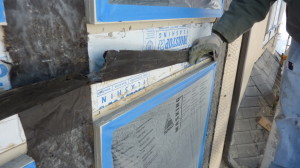
Using window flashing is a must, but installing it properly is even more important. The flashing at the top of this window is directing water right into the home.
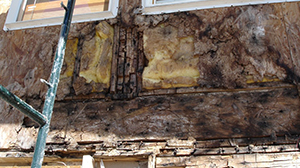
No window flashing was used on this home. No window leaking, no stucco cracks, just a musty smell inside the home.
Window leaks are more common than you would think.
Hidden Damage
When your home has a construction problem, most people want the quickest, cheapest, and easiest fix. If you're told by the handyman that it can be fixed for $50, why spend $500 with a specialized contractor? Many people do not put a high value on our home when it comes to repairs, and we're guilty of it, too! After all, who wants to dump money into a project that gives you no return?
No one thinks they have a major problem. It’s a small amount of water collecting on the window sill, bubbled paint, or damp carpet that generates the phone call. The scary thing is that a window could have a serious leak and you would never know it.
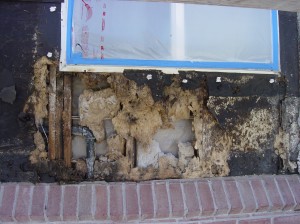
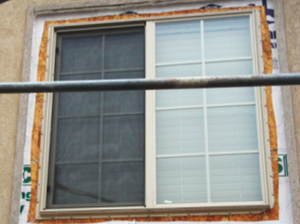
Window Replacement…..fail
We are not always the first company to get the phone call when a home owner thinks there is a problem with their windows. Window replacement companies have been ‘fixing’ window leaks for years. Cut out the old window, slam in the new, and a bead of cheap caulk is the only defense from water intrusion.
On many occasions we have been called out to look at at a home where windows were previously replaced by another contractor. When we show up and see a flush fin or ‘Z’ bar window installed over the exterior cladding, or a window caulked to the exterior cladding, the answer can be hard to swallow: “Sorry ma'am, but the $30,000 you just spent to replace your windows was a complete waste of money and now you have to throw them away and start over.”
Window Replacement Companies
It does not matter what type of exterior cladding you have when trying to decide what to do with your windows. Whether it’s stucco, siding, stone or EIFS, the method of repair should be the same. If you use the cut and caulk method to replace your windows, it is not a permanent fix and often times you will create a much more serious problem.
I hear the ‘used car sales approach’ from siding and window replacement companies on the radio all the time; “Simply the Best for Less” is a commonly heard slogan on our local talk radio station. Window replacement companies are in the business of selling you new windows. They do not make money on the labor and cannot use proper methods because the cost would be way too high for most homeowners. Offering the “Best for Less” should be saved for the local used car salesmen.
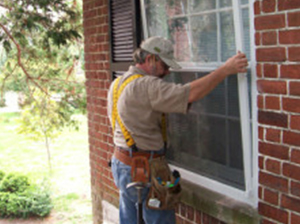
The Proper Approach to Window Replacement and Leaks
Many times when we arrived at a home with leaking windows, we will see caulk smeared all over the exterior of home. Attempts to caulk the window to the exterior cladding will not fix the problem. It is important to remember that the vapor and moisture barrier on your home is what keeps water out, not caulk. (to learn more about this, watch our video “What’s Happening behind your Stucco”).
When you cut through the barrier or existing window flashing, you will leave an avenue for moisture entry no matter how much caulk you try to pump into the gaps. The process of tying in the window frame with the moisture barrier is done using specific window flashing materials. The only way to truly replace your windows, or fix a leaking window, is to tear off the exterior cladding around each window and properly integrate the moisture barrier with approved window flashing material and sealant. This process is not easy, and is often costly when working on existing homes. If builders would pay closer attention to the installation of the windows during original construction, the problems we see with window installation could be reversed for very little additional cost. I do not believe that Home Builders skip the important steps when installing windows to save money. Ignorance is generally the real problem. Knowledge = the competent builder.
